Key takeaways:
- Rain gardens are essential for managing stormwater, reducing flooding, and improving local water quality by absorbing runoff.
- Choosing the right location, selecting native plants, and ensuring proper soil composition are crucial for designing an effective rain garden.
- Regular maintenance practices like inspecting for invasive species, mulching, and hand-watering enhance the garden’s health and effectiveness.

Introduction to Rain Gardens
Rain gardens may sound like a simple landscaping trend, but they serve a vital role in managing stormwater. I remember the first time I saw a rain garden in action; during a heavy downpour, the garden seemed to come alive, effectively absorbing all that water instead of letting it flood the street. Have you ever watched rainwater rush down your driveway, imagining where it all goes?
These gardens are designed to capture runoff from impervious surfaces like driveways and rooftops, allowing the water to soak into the ground rather than overwhelm drainage systems. It’s fascinating to think about how these vibrant, thriving spaces not only enhance our landscapes but also contribute to the health of our local ecosystems. When I dig my hands into the soil of my own rain garden, I feel a connection to nature, knowing I’m playing a part in mitigating the impacts of stormwater.
Furthermore, they create habitats for beneficial wildlife, providing a sanctuary for pollinators and other creatures we rely on. When I see butterflies fluttering around the plants I carefully chose, it fills me with joy. Isn’t it incredible how such a small feature of our gardens can lead to significant environmental benefits?
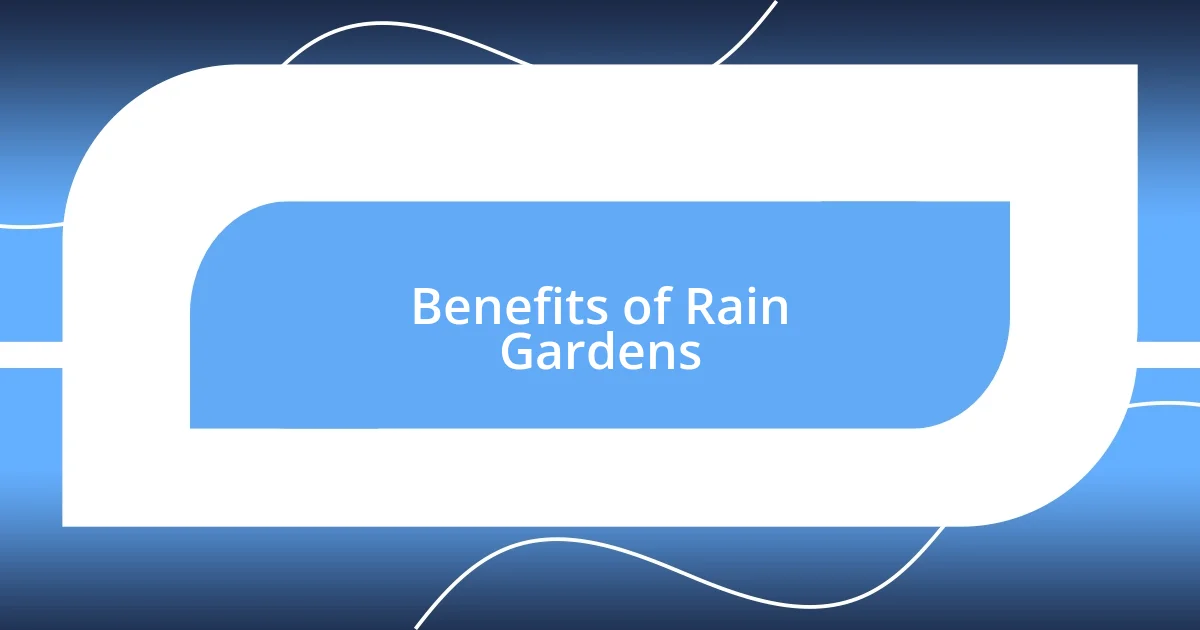
Benefits of Rain Gardens
Rain gardens offer numerous benefits that extend beyond their aesthetic appeal. For me, one of the most significant advantages is their capacity to manage stormwater effectively. I recall the first heavy rain after I installed my own rain garden; I was thrilled to see it absorbing water from my roof and driveway rather than letting it cascade into the street. That moment really underscored the practical value of these gardens.
- Reduced Flooding: They help minimize flooding by absorbing excess rainfall.
- Water Quality Improvement: Rain gardens filter pollutants from runoff, improving local water quality.
- Habitat Creation: They provide critical habitats for pollinators and local wildlife, enhancing biodiversity.
- Aesthetic Enhancement: Rain gardens can beautify landscapes with native plants, attracting a variety of wildlife.
- Groundwater Recharge: By facilitating water infiltration, they help replenish groundwater supplies.
Every time I see the native flowers bloom in my garden, I get a sense of accomplishment knowing I’m contributing positively to the environment. It’s not just about managing water; it’s about nurturing life.
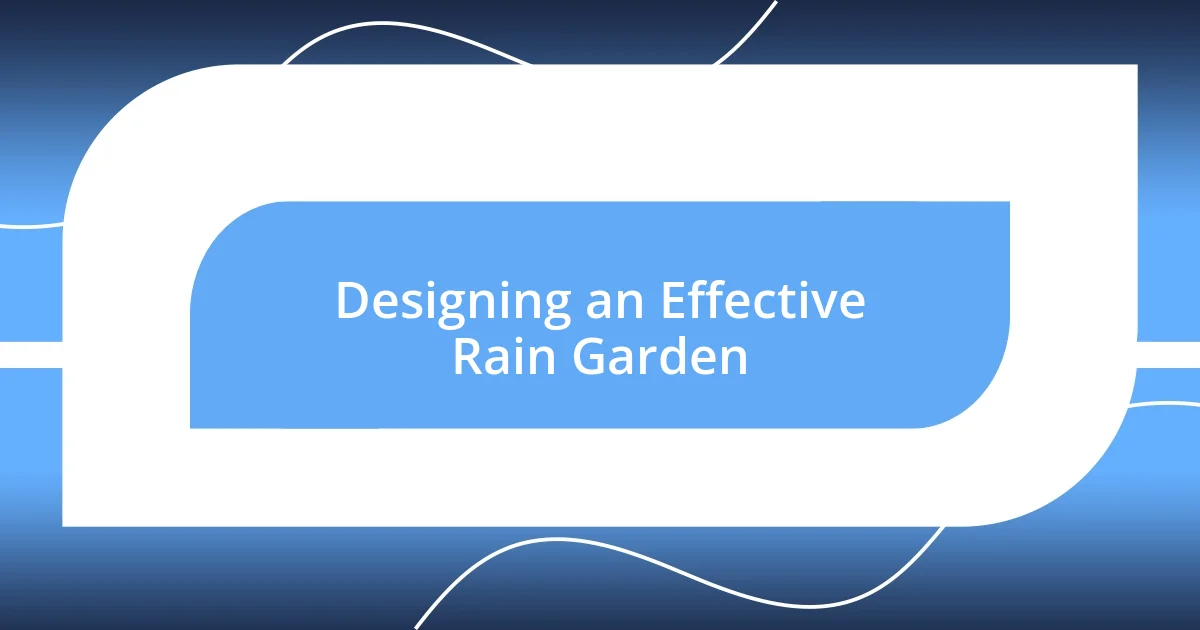
Designing an Effective Rain Garden
When designing an effective rain garden, I find that choosing the right location is crucial. Ideally, you should place it where water naturally collects, like at the bottom of a slope or near downspouts. I remember the first time I picked a spot for my garden; I noticed how water pooled after rain, making it the perfect location. It’s rewarding to see how simply selecting the right site can set the foundation for a thriving ecosystem.
Another aspect I emphasize is selecting appropriate plants. Native species are often the best choice since they tend to thrive in local conditions and require less maintenance. When I incorporated native grasses and wildflowers into my rain garden, I felt a sense of pride knowing I was supporting local wildlife. Have you ever watched bees buzzing around your flowers? It’s a joyful reminder of the essential role these plants play in our environment.
Lastly, I believe that understanding soil composition is vital. A well-draining soil allows water to infiltrate effectively while preventing standing water. In my own experience, mixing in compost helped improve my garden’s drainage and fertility, making it even more vibrant. Have you considered testing your soil before planting? It’s a small step that can lead to significant improvements in your rain garden’s success.
| Aspect | Importance |
|---|---|
| Location | Choosing a spot where water collects ensures optimal absorption and function. |
| Plants | Native plants support local biodiversity and require less maintenance. |
| Soil Composition | Well-drained soil is essential for managing water effectively and sustaining plant health. |
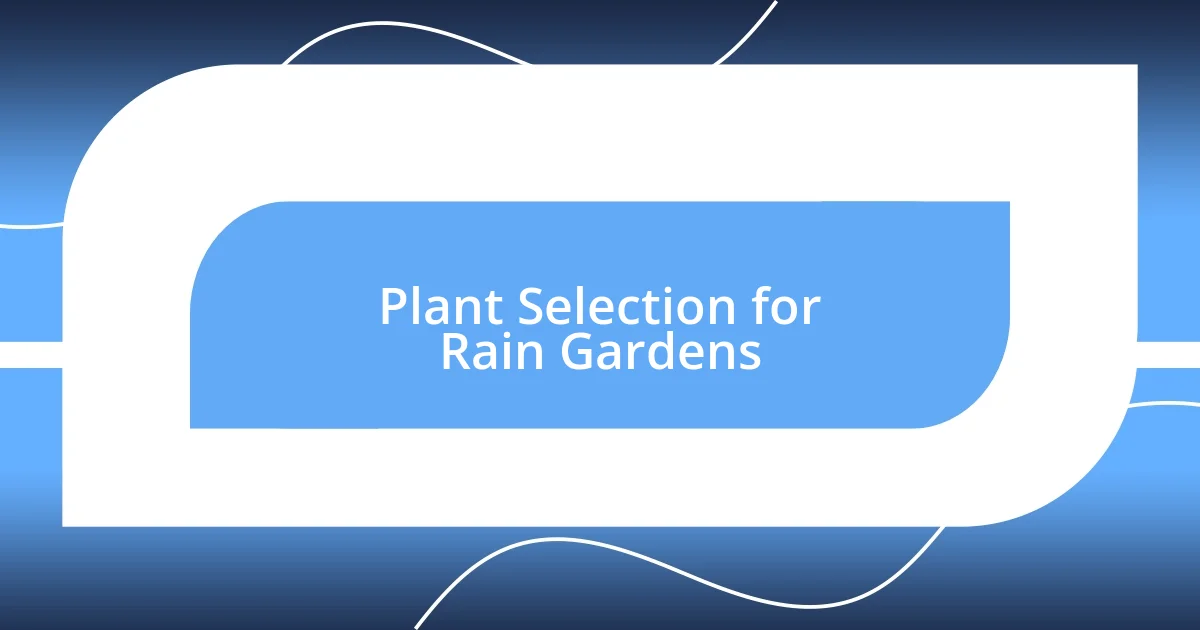
Plant Selection for Rain Gardens
Selecting the right plants for a rain garden can truly make or break the effectiveness of your design. My first attempt included a variety of flowers, and I was amazed at how quickly the native plants flourished. I often ask myself, “What would I want to see in my garden?” and that’s when I landed on vibrant samples like coneflowers and bee balm. Not only do they add color, but they also create a feast for the pollinators that visit my garden.
It’s important to consider different plant layers too. I’ve found that incorporating a mix of tall, mid-height, and ground-cover plants creates a beautiful, lush habitat while effectively managing water. For example, the tall sunflowers add a stunning vertical element, while sedges help stabilize the soil. Have you thought about how various heights can enhance both aesthetics and function? It certainly transformed the dynamics of my rain garden.
Lastly, I feel it’s essential to focus on seasonal interest when choosing plants. I remember the thrill of seeing my rain garden change with the seasons—colorful blooms in spring and vibrant foliage in autumn. This diversity not only keeps my environment lively but also provides year-round assistance to birds and insects. What joy it brings to witness nature’s tapestry unfold right in my backyard!
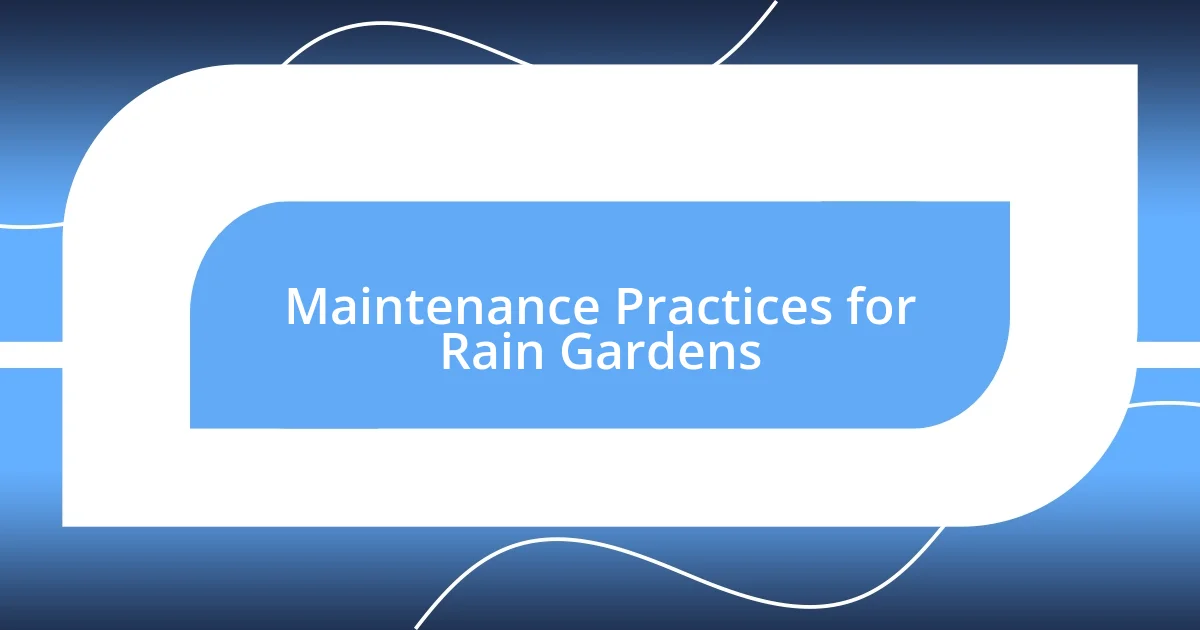
Maintenance Practices for Rain Gardens
Maintenance of rain gardens is essential for keeping them effective and beautiful. I’ve learned over time that regular inspection is crucial—looking out for any invasive plants that might sneak in can save you a lot of trouble later. For instance, I once neglected this step, and before I knew it, a pesky weed took over my garden, overshadowing my beloved wildflowers. Have you ever faced a similar challenge? It truly made me appreciate the need for vigilance.
Another practice I’ve incorporated is seasonal mulching. I find that adding a fresh layer of mulch not only helps retain moisture but also prevents erosion after heavy rains. I remember the feeling of accomplishment when I saw how mulch kept my plants stable during a storm. It was rewarding to witness the positive impact of this simple task and how it allowed my rain garden to thrive, even in turbulent weather.
Lastly, I can’t stress enough the importance of watering, especially during dry spells. In dry periods, I’ve taken to hand-watering certain plants—a small act that profoundly affects their health. It’s a chance for me to connect with my garden, nurturing its growth. Have you ever felt that bond while tending to your plants? It’s these little moments that make maintaining a rain garden so fulfilling.
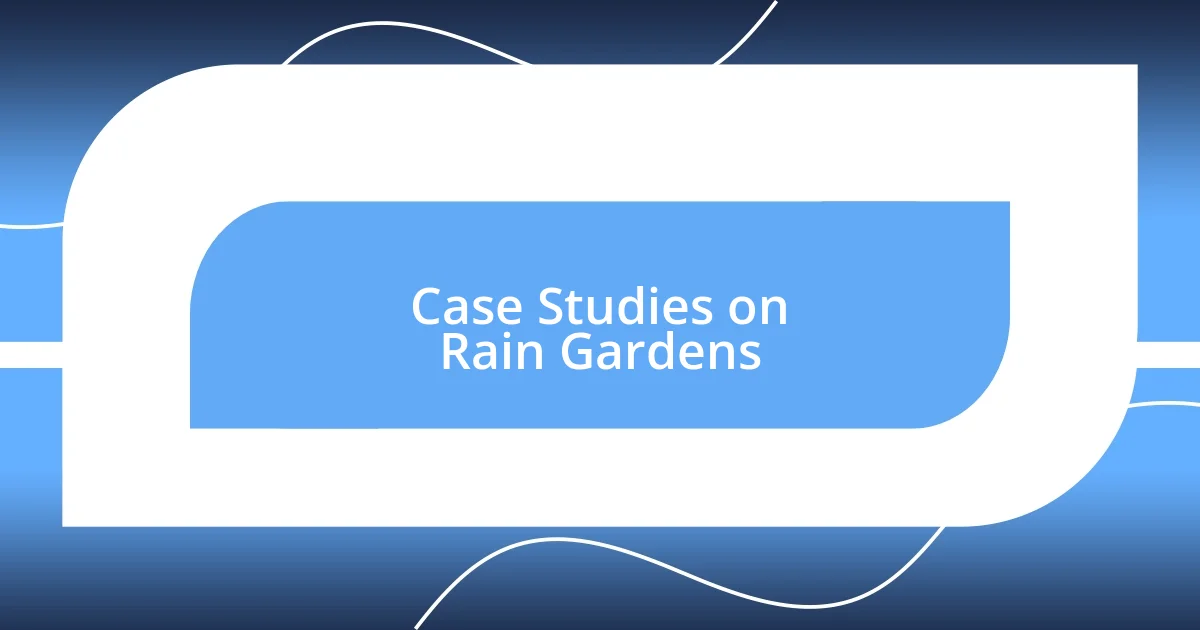
Case Studies on Rain Gardens
When exploring case studies on rain gardens, I often reflect on a local initiative that transformed a previously flood-prone lot into a thriving rain garden. The community came together, inspired by the goal of improving stormwater management while beautifying their neighborhood. Witnessing the collective enthusiasm reminded me how powerful community engagement can be; it’s not just about plants, but people coming together for a common purpose. Have you considered how your own community could benefit from such a project?
One particularly inspiring example I encountered was in a small town where rain gardens were incorporated into school grounds. The school not only utilized these gardens for stormwater management but also turned them into living laboratories for students. As they learned to monitor soil moisture and plant health, I could see their curiosity blossoming. Isn’t it incredible how educational experiences like these can tie nature and stewardship together, fostering a generation that respects and understands the environment?
Another compelling case study I looked into was a city park where rain gardens were strategically placed along pathways. The transformation was striking; the gardens not only improved drainage but also became serene retreats for park visitors. I remember the first time I strolled through and felt the calming effect of the lush greenery and the delicate sounds of water filtering through. Isn’t it fascinating how function and beauty can coexist in such designs? It truly made me appreciate the multifaceted role of rain gardens in urban landscapes.
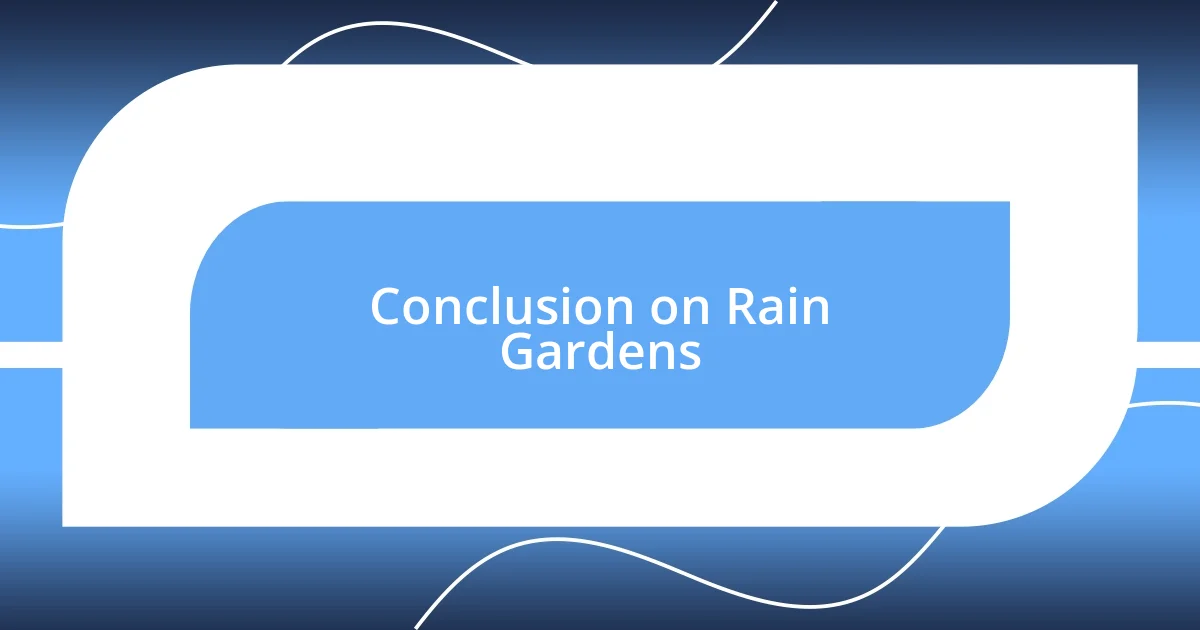
Conclusion on Rain Gardens
The benefits of rain gardens in stormwater management are clear. They not only help mitigate flooding but also enhance local biodiversity. I’ve often left my rain garden feeling reassured, knowing that I’m contributing to a healthier ecosystem in my own backyard. Does it ever cross your mind how such small efforts can lead to significant ecological changes?
Reflecting on my journey, I’ve realized that the emotional connection we foster with our gardens reinforces their importance in our lives. When I see a butterfly flitting from plant to plant, it reminds me that my garden is more than just a functional space; it’s a vibrant haven for wildlife. Have you experienced those moments when nature’s beauty captivates your heart and reminds you why you started this endeavor?
Ultimately, engaging with rain gardens allows us to take an active role in environmental stewardship while creating beautiful spaces. Each step we take to maintain them is a step toward sustainability. When I consider all that I’ve learned, it feels empowering to know that I’m part of a wider movement toward responsible gardening practices. Imagine if everyone nurtured their own green space—what a difference we would see!












